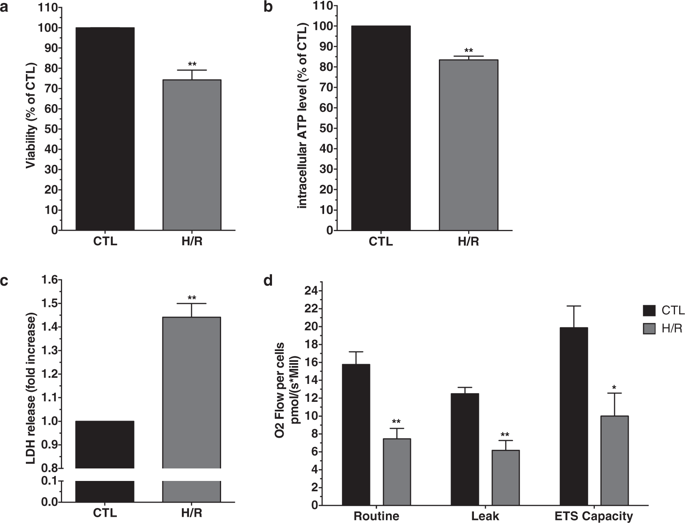Our official English website, www.x-mol.net, welcomes your
feedback! (Note: you will need to create a separate account there.)
Stimulation of P2Y11 receptor protects human cardiomyocytes against Hypoxia/Reoxygenation injury and involves PKCε signaling pathway.
Scientific Reports ( IF 3.8 ) Pub Date : 2019-08-12 , DOI: 10.1038/s41598-019-48006-6 Lauriane Benoist 1 , Stéphanie Chadet 1 , Thibaud Genet 2 , Claudie Lefort 1 , Audrey Heraud 1 , Maria D Danila 3 , Danina M Muntean 3 , Christophe Baron 1, 4 , Denis Angoulvant 1, 2 , Dominique Babuty 2 , Thierry Bourguignon 1, 5 , Fabrice Ivanes 1, 2
Scientific Reports ( IF 3.8 ) Pub Date : 2019-08-12 , DOI: 10.1038/s41598-019-48006-6 Lauriane Benoist 1 , Stéphanie Chadet 1 , Thibaud Genet 2 , Claudie Lefort 1 , Audrey Heraud 1 , Maria D Danila 3 , Danina M Muntean 3 , Christophe Baron 1, 4 , Denis Angoulvant 1, 2 , Dominique Babuty 2 , Thierry Bourguignon 1, 5 , Fabrice Ivanes 1, 2
Affiliation

|
Sterile inflammation is a key determinant of myocardial reperfusion injuries. It participates in infarct size determination in acute myocardial infarction and graft rejection following heart transplantation. We previously showed that P2Y11 exerted an immunosuppressive role in human dendritic cells, modulated cardiofibroblasts' response to ischemia/reperfusion in vitro and delayed graft rejection in an allogeneic heterotopic heart transplantation model. We sought to investigate a possible role of P2Y11 in the cellular response of cardiomyocytes to ischemia/reperfusion. We subjected human AC16 cardiomyocytes to 5 h hypoxia/1 h reoxygenation (H/R). P2Y11R (P2Y11 receptor) selective agonist NF546 and/or antagonist NF340 were added at the onset of reoxygenation. Cellular damages were assessed by LDH release, MTT assay and intracellular ATP level; intracellular signaling pathways were explored. The role of P2Y11R in mitochondria-derived ROS production and mitochondrial respiration was investigated. In vitro H/R injuries were significantly reduced by P2Y11R stimulation at reoxygenation. This protection was suppressed with P2Y11R antagonism. P2Y11R stimulation following H2O2-induced oxidative stress reduced mitochondria-derived ROS production and damages through PKCε signaling pathway activation. Our results suggest a novel protective role of P2Y11 in cardiomyocytes against reperfusion injuries. Pharmacological post-conditioning targeting P2Y11R could therefore contribute to improve myocardial ischemia/reperfusion outcomes in acute myocardial infarction and cardiac transplantation.
中文翻译:

刺激P2Y11受体可保护人心肌细胞免受缺氧/复氧损伤,并涉及PKCε信号通路。
无菌炎症是心肌再灌注损伤的关键决定因素。它参与急性心肌梗死的梗死面积测定以及心脏移植后的移植物排斥反应。我们以前显示P2Y11在人类树突状细胞中发挥免疫抑制作用,在体外异基因异位心脏移植模型中调节心脏成纤维细胞对局部缺血/再灌注的反应以及延迟的移植排斥。我们试图研究P2Y11在心肌细胞对缺血/再灌注的细胞反应中的可能作用。我们对人类AC16心肌细胞进行了5 h缺氧/ 1 h复氧(H / R)。在复氧开始时添加P2Y11R(P2Y11受体)选择性激动剂NF546和/或拮抗剂NF340。通过LDH释放,MTT测定和细胞内ATP水平评估细胞损伤。探索细胞内信号通路。研究了P2Y11R在源自线粒体的ROS产生和线粒体呼吸中的作用。复氧时P2Y11R刺激可显着减少体外H / R损伤。P2Y11R拮抗作用抑制了这种保护作用。H2O2诱导的氧化应激后的P2Y11R刺激减少了线粒体衍生的ROS产生,并通过PKCε信号通路激活而破坏。我们的结果表明,P2Y11在心肌细胞中具有抗再灌注损伤的新型保护作用。因此,针对P2Y11R的药理学后处理可能有助于改善急性心肌梗塞和心脏移植中的心肌缺血/再灌注结果。研究了P2Y11R在源自线粒体的ROS产生和线粒体呼吸中的作用。复氧时P2Y11R刺激可显着减少体外H / R损伤。P2Y11R拮抗作用抑制了这种保护作用。H2O2诱导的氧化应激后的P2Y11R刺激减少了线粒体衍生的ROS产生,并通过PKCε信号通路激活而破坏。我们的结果表明,P2Y11在心肌细胞中具有抗再灌注损伤的新型保护作用。因此,针对P2Y11R的药理学后处理可能有助于改善急性心肌梗塞和心脏移植中的心肌缺血/再灌注结果。研究了P2Y11R在源自线粒体的ROS产生和线粒体呼吸中的作用。复氧时P2Y11R刺激可显着减少体外H / R损伤。P2Y11R拮抗作用抑制了这种保护作用。H2O2诱导的氧化应激后的P2Y11R刺激减少了线粒体衍生的ROS产生,并通过PKCε信号通路激活而破坏。我们的结果表明,P2Y11在心肌细胞中具有抗再灌注损伤的新型保护作用。因此,针对P2Y11R的药理学后处理可能有助于改善急性心肌梗塞和心脏移植中的心肌缺血/再灌注结果。P2Y11R拮抗作用抑制了这种保护作用。H2O2诱导的氧化应激后的P2Y11R刺激减少了线粒体衍生的ROS产生,并通过PKCε信号通路激活而破坏。我们的结果表明,P2Y11在心肌细胞中具有抗再灌注损伤的新型保护作用。因此,针对P2Y11R的药理学后处理可能有助于改善急性心肌梗塞和心脏移植中的心肌缺血/再灌注结果。P2Y11R拮抗作用抑制了这种保护作用。H2O2诱导的氧化应激后的P2Y11R刺激减少了线粒体衍生的ROS产生,并通过PKCε信号通路激活而破坏。我们的结果表明,P2Y11在心肌细胞中具有抗再灌注损伤的新型保护作用。因此,针对P2Y11R的药理后条件处理可能有助于改善急性心肌梗塞和心脏移植中的心肌缺血/再灌注结果。
更新日期:2019-08-12
中文翻译:

刺激P2Y11受体可保护人心肌细胞免受缺氧/复氧损伤,并涉及PKCε信号通路。
无菌炎症是心肌再灌注损伤的关键决定因素。它参与急性心肌梗死的梗死面积测定以及心脏移植后的移植物排斥反应。我们以前显示P2Y11在人类树突状细胞中发挥免疫抑制作用,在体外异基因异位心脏移植模型中调节心脏成纤维细胞对局部缺血/再灌注的反应以及延迟的移植排斥。我们试图研究P2Y11在心肌细胞对缺血/再灌注的细胞反应中的可能作用。我们对人类AC16心肌细胞进行了5 h缺氧/ 1 h复氧(H / R)。在复氧开始时添加P2Y11R(P2Y11受体)选择性激动剂NF546和/或拮抗剂NF340。通过LDH释放,MTT测定和细胞内ATP水平评估细胞损伤。探索细胞内信号通路。研究了P2Y11R在源自线粒体的ROS产生和线粒体呼吸中的作用。复氧时P2Y11R刺激可显着减少体外H / R损伤。P2Y11R拮抗作用抑制了这种保护作用。H2O2诱导的氧化应激后的P2Y11R刺激减少了线粒体衍生的ROS产生,并通过PKCε信号通路激活而破坏。我们的结果表明,P2Y11在心肌细胞中具有抗再灌注损伤的新型保护作用。因此,针对P2Y11R的药理学后处理可能有助于改善急性心肌梗塞和心脏移植中的心肌缺血/再灌注结果。研究了P2Y11R在源自线粒体的ROS产生和线粒体呼吸中的作用。复氧时P2Y11R刺激可显着减少体外H / R损伤。P2Y11R拮抗作用抑制了这种保护作用。H2O2诱导的氧化应激后的P2Y11R刺激减少了线粒体衍生的ROS产生,并通过PKCε信号通路激活而破坏。我们的结果表明,P2Y11在心肌细胞中具有抗再灌注损伤的新型保护作用。因此,针对P2Y11R的药理学后处理可能有助于改善急性心肌梗塞和心脏移植中的心肌缺血/再灌注结果。研究了P2Y11R在源自线粒体的ROS产生和线粒体呼吸中的作用。复氧时P2Y11R刺激可显着减少体外H / R损伤。P2Y11R拮抗作用抑制了这种保护作用。H2O2诱导的氧化应激后的P2Y11R刺激减少了线粒体衍生的ROS产生,并通过PKCε信号通路激活而破坏。我们的结果表明,P2Y11在心肌细胞中具有抗再灌注损伤的新型保护作用。因此,针对P2Y11R的药理学后处理可能有助于改善急性心肌梗塞和心脏移植中的心肌缺血/再灌注结果。P2Y11R拮抗作用抑制了这种保护作用。H2O2诱导的氧化应激后的P2Y11R刺激减少了线粒体衍生的ROS产生,并通过PKCε信号通路激活而破坏。我们的结果表明,P2Y11在心肌细胞中具有抗再灌注损伤的新型保护作用。因此,针对P2Y11R的药理学后处理可能有助于改善急性心肌梗塞和心脏移植中的心肌缺血/再灌注结果。P2Y11R拮抗作用抑制了这种保护作用。H2O2诱导的氧化应激后的P2Y11R刺激减少了线粒体衍生的ROS产生,并通过PKCε信号通路激活而破坏。我们的结果表明,P2Y11在心肌细胞中具有抗再灌注损伤的新型保护作用。因此,针对P2Y11R的药理后条件处理可能有助于改善急性心肌梗塞和心脏移植中的心肌缺血/再灌注结果。





















































 京公网安备 11010802027423号
京公网安备 11010802027423号